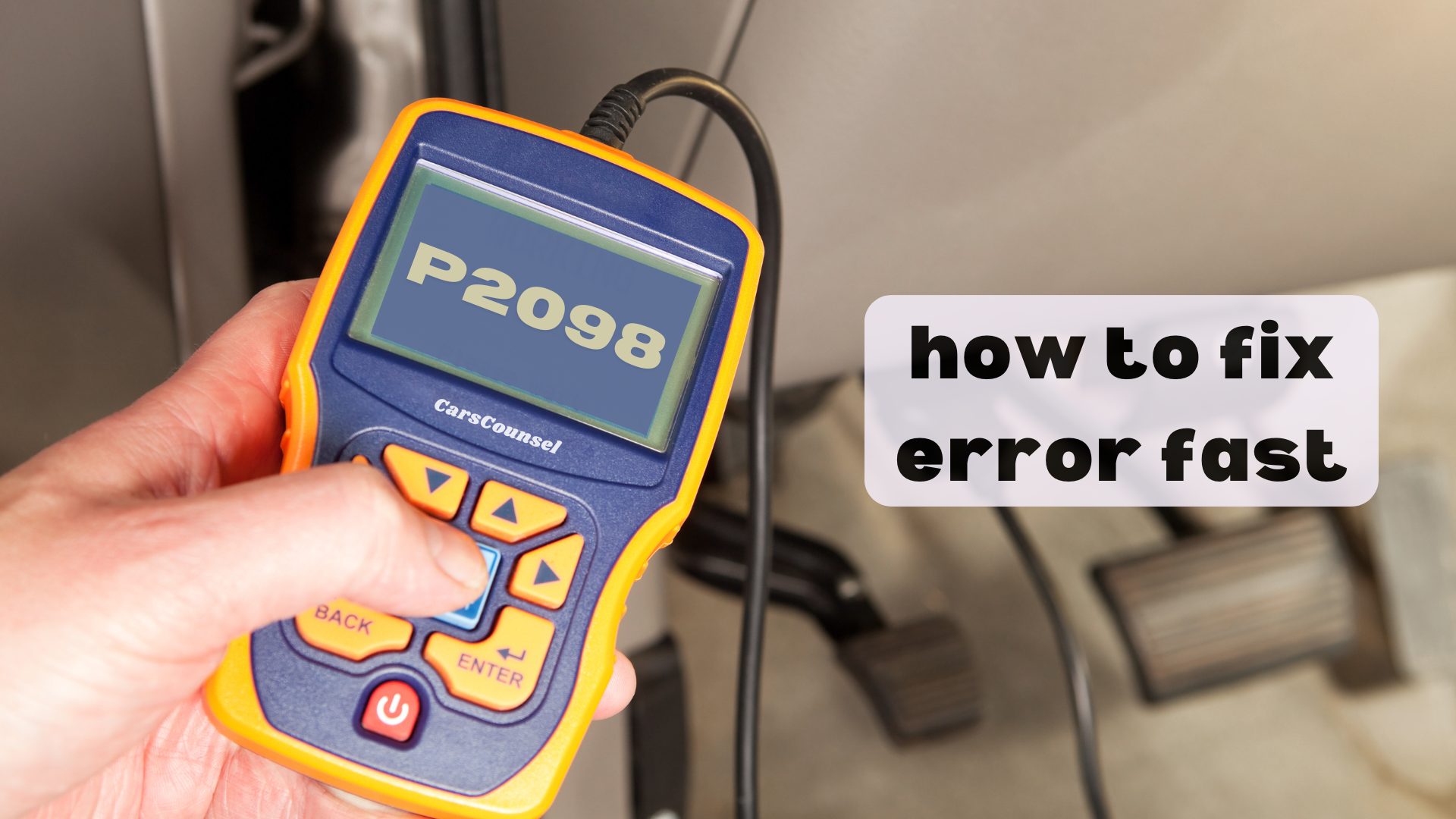Dealing with a P2098 code can be frustrating, but you can handle it efficiently with the right steps.
First, use an OBD-II scanner to identify the exact problem and any related OBD2 Codes issues.
Next, check the exhaust system for leaks or damage land test the downstream oxygen sensor. If the sensor is faulty, replacing it could be a quick fix.
However, there are other parts you should check to ensure your engine runs smoothly.
Want to know what else might be causing the issue?

Quick Navigation
Key Takeaways
- Replace the faulty downstream oxygen sensor to get accurate exhaust readings.
- Look over the exhaust system for any leaks or visible damage and fix them if needed.
- Check how well the catalytic converter is working with an infrared thermometer or a backpressure gauge.
- Test the fuel system to see if there are clogged filters or injectors that aren’t working right, and fix any problems you find.
What Is the P2098 Code?
The P2098 code is an error code that shows there’s a problem with the oxygen sensor located after the catalytic converter. This sensor’s job is to measure the oxygen levels in the exhaust.
When it detects too much oxygen, it triggers the P2098 code, indicating that the sensor’s readings are off. This sensor is important because it helps the engine control module (ECM) keep the right air-fuel mixture.
If the sensor isn’t working correctly, you might notice your car idling roughly, accelerating poorly, or even misfiring.
Fixing the P2098 code quickly is crucial to keep your engine running smoothly and to prevent more serious issues with your car’s exhaust system.
Common Causes of P2098
A faulty downstream oxygen sensor often causes the P2098 code by sending wrong readings to the engine control module (ECM). If the sensor isn’t calibrated right, it gives bad data, making the ECM flag an issue.
Problems with the catalytic converter, like clogging or damage, can also cause high oxygen levels, triggering the code. Exhaust system leaks can mess up sensor readings, making it harder for the ECM to control the air-fuel mix.
Issues with the fuel system, like clogged filters or bad injectors, can create a rich mixture, affecting the downstream sensor. Keeping up with exhaust maintenance and calibrating sensors on time can help prevent these problems.
Fixing these common causes quickly ensures your engine runs well and avoids more issues.
Symptoms of P2098 Code
Having a P2098 code usually means your car’s engine isn’t performing as well as it should, and it’s using more fuel. You might see the check engine light come on, which is a sign there’s a problem. Common symptoms include strange noises or smells from the exhaust, which can affect how your car drives. One of the main signs is a change in how your car accelerates; it might feel slow or not as responsive.
Here’s a quick summary:
| Symptom | Description |
|---|---|
| Poor Engine Performance | Less power and slow acceleration |
| Lower Fuel Efficiency | Using more fuel and costing more to run |
| Check Engine Light | Light on the dashboard |
| Strange Exhaust Noises/Smells | Possible exhaust system problems |
Fixing these issues quickly is important to keep your engine running well and to avoid bigger problems later.
Diagnosing P2098 Code
To diagnose a P2098 code, start by connecting a diagnostic scanner to your car’s OBD-II port to read the stored trouble codes.
Note any related error codes that come up.
Check the exhaust system for any leaks or damage.
Use a multimeter to test if the downstream oxygen sensor is working properly.
Assess the catalytic converter with an infrared thermometer or a backpressure gauge to see if it’s performing well.
Also, inspect the fuel system for any leaks or issues.
This step-by-step approach will help you find the root cause and fix the P2098 code efficiently.
Using a Scanner Tool
Using a Scanner Tool
To figure out what’s causing the P2098 code in your car, you’ll need a good OBD-II scanner. This tool plugs into your car’s diagnostic port and reads the trouble codes stored in the engine control unit (ECU). Picking the right scanner is key for getting accurate information and fixing the issue efficiently.
Benefits of using a scanner include checking real-time data, understanding error codes, and keeping an eye on your car’s overall health.
Here’s a simple guide:
- Connect Scanner: Plug the OBD-II scanner into your car’s diagnostic port.
- Retrieve Codes: Access the ECU to get the P2098 code and any other related codes.
- Analyze Data: Use the scanner to check oxygen sensor readings and other important details.
- Select Tool: Pick a reliable scanner with advanced features for thorough diagnostics.
Follow these steps to make your diagnostic process easier.
Visual Exhaust System Inspection
Visual Exhaust System Inspection
Take a close look at the exhaust system to find any clear signs of damage, leaks, or wear that could be causing the P2098 code. Pay special attention to welds, joints, and the condition of the pipes. Look for rust, holes, or discolored spots that might indicate leaks. Also, check the catalytic converter for any damage or unusual color changes. Make sure that the clamps and mounting points are securely attached and not corroded.
| Component | Possible Issue | Emotional Impact |
|---|---|---|
| Welds and Joints | Cracks, Leaks | Frustration |
| Catalytic Converter | Damage, Discoloration | Anxiety |
| Exhaust Pipes | Rust, Holes | Concern |
| Clamps and Mounts | Loose, Corroded | Worry |
| Overall System | Wear, Damage | Unease |
This visual inspection is crucial to quickly find and fix the problem.
Testing Oxygen Sensors
Testing oxygen sensors means using a multimeter to check the voltage and resistance, making sure they send accurate data to the engine control unit (ECU). Different types of oxygen sensors, like zirconia and titania, need specific testing methods.
Here’s how you can test them:
- Find the Sensor: Locate the downstream oxygen sensor in your exhaust system.
- Check Voltage: Use the multimeter to measure the sensor voltage; it should go up and down between 0.1 and 0.9 volts.
- Measure Resistance: Test the sensor’s heater circuit resistance; look up the correct values in the vehicle’s service manual.
- Compare Data: Make sure the readings match the manufacturer’s specs to confirm the sensor is working right.
Proper testing is crucial for diagnosing and fixing the P2098 code correctly.
Assessing Catalytic Converter
After checking the oxygen sensor, you should test the catalytic converter to make sure it’s reducing emissions properly.
Start by using an infrared thermometer to see if there are any unusual temperature differences between the converter’s inlet and outlet. You can also use a backpressure gauge to check if there’s any blockage in the converter.
Make sure your tools are accurate for the best results. Regularly check the catalytic converter for any physical damage, blockages, or contamination.
Look for signs of wear or melting to catch problems early. Always follow the manufacturer’s guidelines for testing to ensure your converter is working well and meeting emissions standards.
Fixing P2098 Issues
Fixing P2098 problems usually begins with replacing the faulty oxygen sensor located downstream to ensure accurate exhaust readings. Keeping the sensor in good shape helps the engine control unit (ECU) get reliable data.
Next, check the exhaust system for any leaks or damage, as these can mess up the sensor readings and need to be fixed right away.
Here’s a simple step-by-step guide:
- Replace the Downstream Oxygen Sensor: Change out the bad sensor to get accurate exhaust data again.
- Check the Exhaust System: Look for leaks or damage using visual checks and pressure tests.
- Test the Catalytic Converter: Use an infrared thermometer to make sure it’s working properly.
- Check the Fuel System: Look for clogged filters or faulty injectors that might be affecting the exhaust.
Focusing on these areas will help you quickly solve P2098 code issues.
Preventing P2098 Code
To prevent the P2098 code from coming up, keep your car’s exhaust and fuel systems in good shape with regular checks and replacements. Follow a solid maintenance schedule.
Change the downstream oxygen sensor as suggested by your car’s manufacturer to keep it working right. Look at the catalytic converter and exhaust system for any damage or leaks and fix them quickly.
Do regular oil changes and tune-ups to keep the engine running well. Check the fuel system parts, like injectors and filters, for any problems or clogs.
Drive gently to avoid wearing out the exhaust parts too fast. If you notice any issues with how fuel is delivered or exhaust emissions, take care of them right away to avoid triggering the P2098 code and keep your engine running smoothly.
More OBD-II Codes
Frequently Asked Questions
Can a P2098 Code Affect My Vehicle’s Long-Term Reliability?
Yes, a P2098 code can affect your vehicle’s long-term reliability. It can lead to issues with engine performance and may damage the catalytic converter. This can cause serious reliability problems if not fixed quickly. It’s important to get it diagnosed and repaired right away.
Are There Any Temporary Fixes for a P2098 Code?
Temporary fixes for a P2098 code are like putting a band-aid on a cut. You can try resetting the ECU or checking for exhaust leaks, but these are not permanent solutions and the issue might come back.
How Does the P2098 Code Impact Emissions Test Results?
You can’t pass an emissions test with a P2098 code. Use diagnostic tools to find and fix issues with the oxygen sensor, exhaust leaks, or the catalytic converter. If you don’t fix these problems, your vehicle will produce more emissions and fail the inspection.
Can Driving Habits Influence the Occurrence of a P2098 Code?
Think about tough driving conditions, bad fuel, and lots of stop-and-go traffic. These things can strain your exhaust system, wear out oxygen sensors, and cause the P2098 code to pop up. Driving aggressively makes it worse, leading to more check-ups and fixes.
What Are the Potential Costs for Professional Diagnosis of a P2098 Code?
You’ll usually pay between $100 and $150 to have a professional figure out what’s causing the P2098 code. Fixing the problem can cost different amounts depending on what’s wrong. Changing an oxygen sensor might cost between $150 and $300, but replacing a catalytic converter could cost more than $1,000.
Conclusion
To wrap things up, fixing the P2098 code isn’t too hard. With an OBD-II scanner, you can find the problem like a detective solving a case.
Check the exhaust for leaks, and use a multimeter to test the oxygen sensors. If they’re bad, replace them.
Also, look at the catalytic converter and fuel system for any blockages.
By taking care of these areas, your engine will run smoothly and you’ll avoid future issues.

